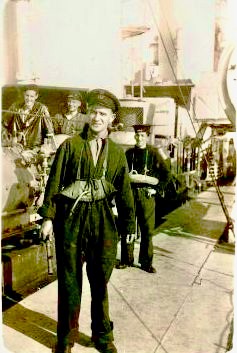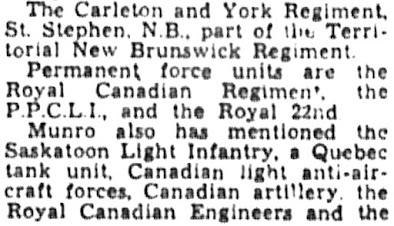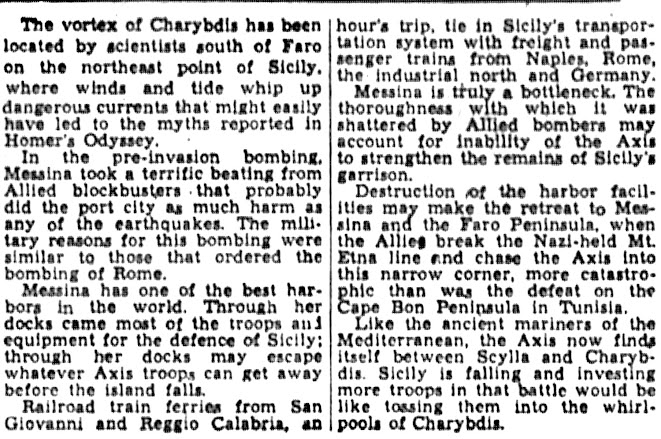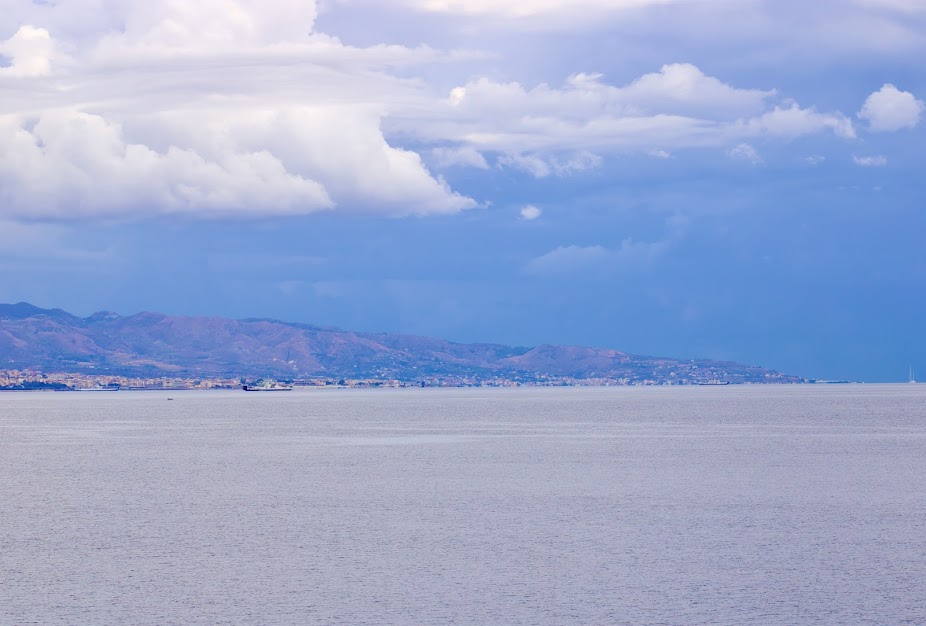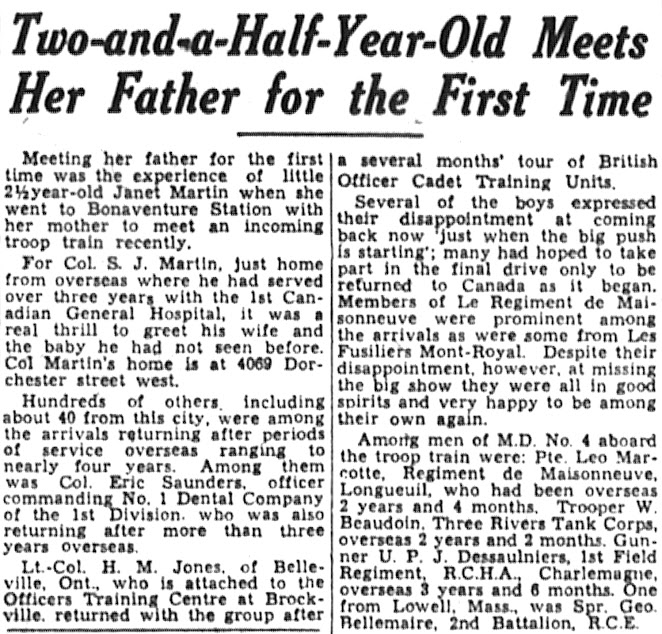The Canadian Army: In Sicily and in Several Headlines!!
Canada's War Correspondents are Eye Witnesses Too
World War II: July 28, 1943, the conquest of Agira
Introduction:
I predict that The Montreal Gazette newspaper will continue to be filled with articles about the advances made by 1,000s of Allied forces in Sicily for at least two more weeks. So, for those readers interested in the exploits of Allied armies, please stay tuned, because well-known Canadian war correspondents Ross Munro (with Canadian Press) and Lionel Shapiro (with The Gazette), as well as others, are in full swing, as evidenced by several news clippings shared here in this post.
Meanwhile, back at the ranch (or eastern shores of Sicily), if you're also interested in the exploits of 400 - 500 Canadians in RCNVR and Combined Ops who in some cases landed troops (in the opening days of Operation HUSKY beginning July 10, 1943) and in other cases are continuing to transport all materials of war ashore (and will do so into the first to second week of August), a few details will be forthcoming when an opportunity presents itself.
As has been often the case on Saturdays, this issue of a significant Canadian newspaper is a thick one, so be prepared for a lengthy collection of clips... with the occasional word from a sponsor or two, e.g., Blondie and Montreal Window Cleaning!
The Canadian Army open a "wide gap" in the German defensive line. And a pocket of Germany's finest didn't see the Canadians coming! But once our artillery said hello, "they gave up in short order."


Near the entrance to the Sicilian town of Agira, Canadian soldiers guard
captured German and Italian fighters waiting for transport to a prison camp
in July 1943. Credit: Canada. Dept. of National Defence / Library and
Ross Munro shares the front page of
The Gazette as well:
Three members of Princess Patricia’s Canadian Light Infantry take aim near
Valguarnera Caropepe, Sicily, on July 20, 1943, as enemy vehicles burn in the
background. Credit: Frank Royal / Canada. Dept. of National Defence/Library
and Archives Canada / PA-163670. Canadian Armed Forces (Facebook)
Ross Munro's article continues:
Sherman tanks of the 14th Canadian Army Tank Regiment move along
a winding mountain road through Sicily in the early morning of July 28,
1943. Credit: Canada. Dept. of National Defence / Library and Archives
Canada PA-141304. Canadian Armed Forces (Facebook)
Munro's article continues:
Several different Canadian regiments were mentioned in the above article. Later in the same issue some information/history was provided about various Canadian regiments active in Sicily, and readers will find these details at the very end of this entry... way, way, way down below.
Drew Middleton's article is next, and he mentions the progress of American troops - under the leadership of Lt.-General George Patton - as well as "the Canadian drive":
Middleton is writing from "Supreme Headquarters of the AEF (Allied
Expeditionary Forces)" somewhere in North Africa. Photo is found at
Middleton's article continues:
Another story starting on the front page of The (Montreal) Gazette, also posted from Allied Headquarters in North Africa:
In this next article a reason is given for why the Canadian First Division troops were called "the red patch devils."
I look forward to reading The War News Digest because it covers action at various war fronts, not just Sicily. (But, they forgot how things are going in the Pacific Theatre!)
Check the Legend in the map below to see the advances of American, British and Canadian forces in Sicily:
Map of Canadian Operations in Sicily, 10 July to 17 August 1943. (Map drawn
by C.C.J. Bond, in C.P. Stacey, The Canadian Army 1939-1945: An Official
Historical Summary (1948), Department of National Defence). Photo from
The War News Digest (last article above) mentioned "Hamburg's obliteration continued with the 105th raid on that port." And immediately below are details of the 105th raid:
"What's new at the movies?" you might wonder.
And if Stan and Ollie don't provide enough comedy relief, stand by for this next offering:
"In winter, snow lies deep on the (Simplon) Pass" and...
And now for a word from our sponsor:
WRNS (Wrens) are hard at work. If readers can find better photos please let me know! (@ gordh7700@gmail.com)
More news from Allied HQ in North Africa:
From The Gazette's Editorial page:
And now a few brief messages from... a Canadian war correspondent:
Not just Canadian war correspondents make Page One:
Canadian charcoal on paper, Helmsman at Night, HMCS Charny, signed
and dated 1944. Provenance: Roberts Gallery, Toronto Private Collection
The Duce tried to get away but he failed at that as well:
One man's "escape hatch" is another man's "back door". Unfortunately Allied forces did not slam it shut before German troops escaped to fight again on the Italian peninsula:
The ferry to San Giovanni is still in operation (as of Sept. 2023). In
Sept. 1943 my father transported Canadian troops and all materials
of war from Messina to Reggio Calabria, a seven-mile roundtrip
Mr. Shapiro of The Gazette writes about the Sicilian campaign and the
German Army's escape via the Messina Strait, or "Sicily's escape hatch"
The above new's article continues here:
Below are three photos from September, 1943 (80 years after my father drove landing crafts across the same waters (i.e., Messina Strait), from a trip to Sicily with my younger son Paul. (We shall return!)
The 'Toe of the Boot' of Italy, as seen from the ferry to San Giovanni
San Giovanni to the left, Reggio Calabria to the right
San Giovanni in the background as we approach its terminal
Stand by your mates.
A swell greeting ("Welcome home, Pops!") at Bonaventure Station, Montreal:
"CANUCKS TAKE (ANOTHER) BASE..." and - as usual! - Ross Munro was there! (He should write a book like Shapiro did!)
Munro did write a book! Not just one.
Mr. Munro's article continues:
Lionel Shapiro seems as busy as Ross Munro. Fortunately we have access to excellent stories as found in The Gazette, other Canadian newspapers (e.g., via microfilm) and well-crafted books:
Apparently, Shapiro (and R. Munro) had access to transportation inland once they were deposited ashore. Though I have not come across stories by them about the Navy boys who landed them ashore while depositing troops and all materials of war (often for weeks at a time), I did find a significant photograph in Shapiro's book (shown earlier) that reveals beaches on Sicily's east coast where the 80th and 81st Canadian Flotillas of Canadian Landing Craft were active from July 10 - August7, 1943:

"Every strip of usable beach was organized as a miniature port."
A view of supply and infantry landing craft on a beach near Syracuse.
This area - HOW Beach near Gallina - was served by the 81st Flotilla
Photo - Facing page 15 in They Left the Back Door Open
Shapiro's article continues below:
Can you tell it's a Saturday newspaper? The stories go on...
A couple of members of the 80th and 81st Canadian Flotillas wrote in memoirs about the beating they took at the hands of the Luftwaffe over the first three days on the east coast, at HOW Sector (or Beach) and a couple of kms farther north at GEORGE Sector near Fontane Bianche. Every two hours they got attacked from the air, but fortunately, as my father said, "small crafts make small targets." He also wrote the following:
July 10, 1943. We arrived off Sicily in the middle of the night and stopped about four miles out. Other ships and new LCIs (landing craft infantry), fairly large barges, were landing troops. Soldiers went off each side of the foc’sle, down steps into the water and then ashore, during which time we saw much tracer fire. This was to be our worst invasion yet. Those left aboard had to wait until daylight so we went fishing for an hour or more, but there were no fish.
A signal came through, i.e., “Do not fire on low flying aircraft, they are ours and towing gliders.” What, in the dark? Next morning. as we slowly moved in, we saw gliders everywhere. I saw them sticking out of the water, crashed on land and in the vineyards. In my twenty-seven days there I did not see a glider intact.
We started unloading supplies with our LCMs about a half mile off the beach and then the worst began - German bombers. We were bombed 36 times in the first 72 hours - at dusk, at night, at dawn and all day long, and they said we had complete command of the air.
We fired at everything. I saw P38s, German and Italian fighters and my first dogfights. Stukas blew up working parties on the beach once when I was only about one hundred feet out. Utter death and carnage. Our American gun crews had nothing but coffee for three or four days and stayed close to their guns all the time. I give them credit.

A signalman sends messages to an LCI (left) and LCT in Sicily
Photo credit - Imperial War Museum (IWM)
Ephus P. Murphy’s pet monkey went mad and we put it in a bag of sand meant to douse incendiary bombs and threw him over the side. The Russian Stoker on our ship, named Katanna, said Dieppe was never like this and hid under a winch. Shrapnel and bombs just rained down.
My oppo (pal, chum), Leading Seaman Herring, was bothered constantly with constipation, but when bombs began to drop close in Sicily, his problem suddenly disappeared, he was so scared. It scared the 'beep beep' right out of him. Hitler’s laxative, so he wasn’t all bad, was he?
Once, with our LCM loaded with high octane gas and a Lorrie (truck), we were heading for the beach when we saw machine gun bullets stitching the water right towards us. Fortunately, an LST (landing ship tank) loaded with bofors (guns) opened up and scared off the planes, or we were gone if the bullets had hit the gas cans. I was hiding behind a truck tire, so was Joe Watson of Simcoe. What good would that have done?
Our beach had machine gun nests carved out of the ever-present limestone, with slots cut in them to cover our beaches. A few hand grenades tossed in during the night silenced them forever.
Slowly we took control and enemy raids were only sporadic, but usually at dawn or dusk when we couldn’t see them and they could see us. At such times we had to get out of our LCMs and lay smoke screens, and travelled the ocean side or beach side depending upon which way the wind was blowing. Even then they could see the masts sticking up. During one raid I was caught on the open deck of the Pio Pico, so I laid down - right on a boiling hot water pipe. I got up quickly.

A stick of Axis bombs lands near LCTs and LCMs near Avola, Sicily.
Photo credit - St. Nazaire to Singaopore, Volume 1
We were never hit but six ships were hit in a sneak attack out of the sun by German fighters carrying a bomb apiece. At night they would drop chandelier flares with their engine motors cut off. Everything would be dark and then suddenly it was like daylight. The flares were on parachutes and took forever to come down. After the flares lighted us up in came the bombers. Fortunately our gunners got so expert they could shoot out the flares.
From "Dad, Well Done," by Gord Harrison And now, another word from our sponsor:
The "famous 'Van Doos' Royal 22nd Regiment... is in the thick of the fighting in Sicily." The Gazette readers from Quebec would be particularly pleased with the latest news:
If your letter starts with "Dear John," don't send it!
Related to the above, in Navy memoirs ("Dad, Well Done" page 91) my father writes:
Liverpool, such a friendly city, has welcomed sailors for centuries and we went ashore soon after our arrival to a seaman's home (after Dad and mates returned from activities in Operation TORCH, i.e., Allied invasion of North Africa in November, 1942), a large, warm, clean barrack-like building with good food, showers, and cots with white sheets and pillow cases. Heaven!
Soon mail arrived and I can still see myself and my friends discarding our boots and stretching out on the cots to read the latest from home.
Everything went quiet until someone shouted, "Hey guys, get a load of this!"
"Pipe down!" (they would reply, followed by) the old familiar phrase, "Read it to us later!"
Dad concluded his brief story by saying, "We shared our parcels with anyone who may have missed out and showed new photos all around."
The loss of "a naval blimp," the K-74 - reportedly a rare occurrence - makes the news. Note the article also appeared in The New York Times, so we may be reading about a U.S. Navy blimp:
A story (with photo above) re the loss of a U.S. Navy blimp off the East
This article appeared close by, as if to even the score:
Help Wanted! Wouldn't it be great to find a much clearer photo of these two veterans of the Dieppe Raid? But where?
This post concludes with a bit of Canadian history re the soldiers marching "shoulder to shoulder", and then their regiments:
(There were more details re the 48th Highlanders but it was unreadable).
Gaelic meaning “Faithful Forever”
More news clippings from
The (Montreal) Gazette will soon follow.
Please click here to view
Research: Three Months in the Mediterranean, 1943 (22)In honour of those who served, Remembrance Day, November 11, 2024 -
J. Goldrick (11/04/2024), as found on Facebook, November 11, 2024
Questions or comments can be sent to gordh7700@gmail.com
Unattributed Photos GH


